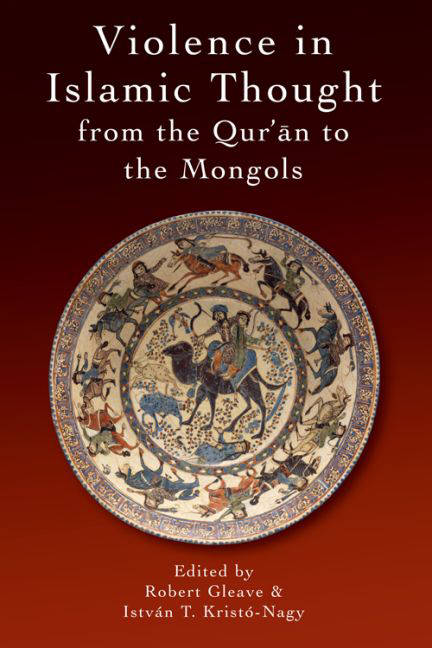Book contents
- Frontmatter
- Contents
- Dates and Abbreviations
- List of Figures and Tables
- 1 INTRODUCTION
- PART I JIHĀD AND CONQUEST: ATTITUDES TO VIOLENCE AGAINST THE EXTERNAL ENEMIES OF THE MUSLIM COMMUNITY
- 2 THE QUESTION OF DIVINE HELP IN THE JIHĀD
- 3 READING THE QURĀN ON JIHĀD: TWO EARLY EXEGETICAL TEXTS
- 4 IBN AL-MUBĀRAK'S KITĀB AL-JIHĀD AND EARLY RENUNCIANT LITERATURE
- 5 SHAPING MEMORY OF THE CONQUESTS: THE CASE OF TUSTAR
- PART II THE CHALLENGED ESTABLISHMENT: ATTITUDES TO VIOLENCE AGAINST THE STATE AND IN ITS DEFENCE WITHIN THE MUSLIM COMMUNITY
- PART III LUST AND FLESH: ATTITUDES TO VIOLENCE AGAINST THE DEFENCELESS, INTRA-COMMUNITARIAN VIOLENCE BY NON-STATE ACTORS
- Bibliography
- Index of Qurānic Citations
- General Index
5 - SHAPING MEMORY OF THE CONQUESTS: THE CASE OF TUSTAR
from PART I - JIHĀD AND CONQUEST: ATTITUDES TO VIOLENCE AGAINST THE EXTERNAL ENEMIES OF THE MUSLIM COMMUNITY
Published online by Cambridge University Press: 15 September 2017
- Frontmatter
- Contents
- Dates and Abbreviations
- List of Figures and Tables
- 1 INTRODUCTION
- PART I JIHĀD AND CONQUEST: ATTITUDES TO VIOLENCE AGAINST THE EXTERNAL ENEMIES OF THE MUSLIM COMMUNITY
- 2 THE QUESTION OF DIVINE HELP IN THE JIHĀD
- 3 READING THE QURĀN ON JIHĀD: TWO EARLY EXEGETICAL TEXTS
- 4 IBN AL-MUBĀRAK'S KITĀB AL-JIHĀD AND EARLY RENUNCIANT LITERATURE
- 5 SHAPING MEMORY OF THE CONQUESTS: THE CASE OF TUSTAR
- PART II THE CHALLENGED ESTABLISHMENT: ATTITUDES TO VIOLENCE AGAINST THE STATE AND IN ITS DEFENCE WITHIN THE MUSLIM COMMUNITY
- PART III LUST AND FLESH: ATTITUDES TO VIOLENCE AGAINST THE DEFENCELESS, INTRA-COMMUNITARIAN VIOLENCE BY NON-STATE ACTORS
- Bibliography
- Index of Qurānic Citations
- General Index
Summary
The military conquest of a hostile territory and its population is a paradigmatic form of violence and leaves deep imprints on the memories of the conquerors and the vanquished alike. Examining these imprints and the ways in which they are manipulated by later narrators in specific historical cases can bring to light the multiple functions that memories of violent conquest can serve. An interesting case study is provided by the Muslim conquest of the Iranian city of Tustar. Towards the end of a short seventh-century Nestorian work known as the Khūzistān Chronicle, we find as something of an appendix an account of the Arab conquest of the region and of Shūsh and Shūstrā, or as Arabs came to know the towns, al-Sūs and Tustar. The Chronicle was completed, at the latest, by 680 and is widely recognised as providing a rare window into events, because of its detailed reporting and proximity. It notes that ‘at the time of which we have been speaking, when the Ṭayyāyē’ – that is, the Arabs – ‘conquered all the territory of the Persians and Byzantines, they also entered and overran Bēt Hūzāyē, conquering all the strong towns’. There remained only Sūs and Tustar, which were extremely well fortified, controlled by the Persian forces commanded by Yazdagird (r. 632–51) and one of his commanders, called ‘Hormīzdān the Mede’. The Chronicle tells us that the Arabs were led by Abū Mūsā, who built Basra to settle the Arabs, just as Sad, son of [Abū] Waqqāṣ, had built Kufa. There is reporting on the first conflicts between al-Hurmuzān and Abū Mūsā, al-Hurmuzān's breaking of a truce, his killing of the men who had served as ambassadors between him and the Arabs and the bloody defeat of al-Sūs. Then we learn that the Arabs besieged Tustar, fighting for two years to take it. Finally, a man from the province of Bēt Qaṭrāyē, who lived in Tustar, befriended a man who had a house on the walls of the city, and the two of them conspired together and went out to the Arabs, promising them: ‘If you give us a third of the spoils of the city, we will let you into it.’
- Type
- Chapter
- Information
- Publisher: Edinburgh University PressPrint publication year: 2015

